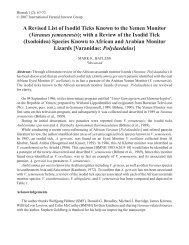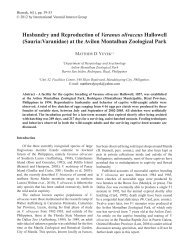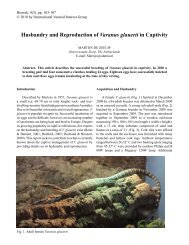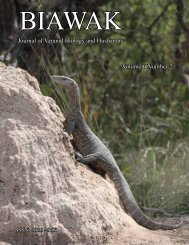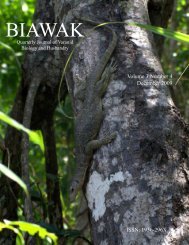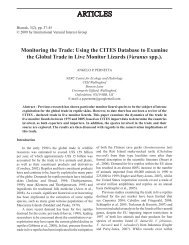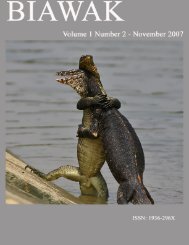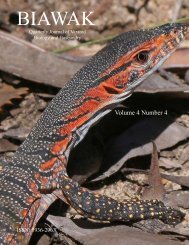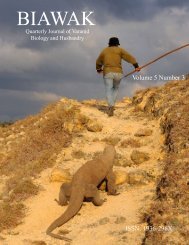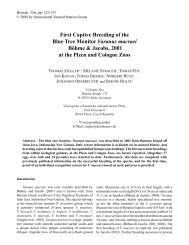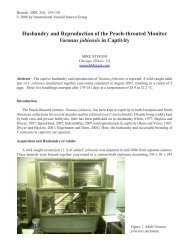BIAWAK - International Varanid Interest Group
BIAWAK - International Varanid Interest Group
BIAWAK - International Varanid Interest Group
Create successful ePaper yourself
Turn your PDF publications into a flip-book with our unique Google optimized e-Paper software.
Biawak, 3(2), pp. 61-63<br />
© 2009 by <strong>International</strong> <strong>Varanid</strong> <strong>Interest</strong> group<br />
Cannibalism in Captive Varanus timorensis<br />
csABA géczY<br />
Gyöngyvirág út 3/a<br />
1125. Budapest, Hungary<br />
E-mail: sbcsaba@gmail.com<br />
Abstract - An observation of cannibalism among sibling Varanus timorensis in captivity is presented. It is<br />
suggested that cannibalism may not be common in V. timorensis, however care should be taken when housing<br />
animals together.<br />
An adult pair of wild-caught Varanus timorensis has<br />
been kept in captivity since 2004 in the author’s private<br />
collection. On 5 February 2008, the female laid 13 eggs<br />
(8 fertile and 5 infertile). The eggs were placed into an<br />
aquarium-type incubator with an incubation substrate<br />
consisting of a perlite and water mixture (1:1 ratio by<br />
weight). The eggs were incubated at 29 °c, and began<br />
to hatch on 1 June 2008, after 117 days. small slits were<br />
made on the eggs that hadn’t pipped by themselves; one<br />
neonate was found dead in the egg. By the next day, all<br />
remaining hatchlings emerged, four healthy monitors<br />
and three with congenital spine deformities. The healthy<br />
hatchlings averaged 6.5 cm in snout to vent length (sVL)<br />
and 16 cm in total length (TL), and 4 g.<br />
The seven hatchlings were placed together in a<br />
glass enclosure measuring 50 x 30 x 35 cm (l x w x h).<br />
Fig. 1. Hatchling Varanus timorensis emerging from eggs.<br />
The enclosure consisted of newspaper substrate, cork<br />
bark-covered enclosure walls, numerous branches and<br />
a shallow water dish (2 cm deep). The ambient room<br />
temperature was maintained at 27 ºc and a 26 W Exoterra<br />
Reptiglo 5.0 light bulb was placed on the top of<br />
the enclosure for additional basking and uVB exposure.<br />
Two out of the three deformed monitors died within 2<br />
days of hatching, both found dead in the water dish.<br />
The remaining one started to eat, along with the healthy<br />
ones, on wild-caught insects dusted with Korvimin<br />
zVT+Reptil vitamin and mineral supplement. Food<br />
was offered on a daily basis. Despite some difficulties<br />
in moving, the deformed juvenile gained weight. Minor<br />
fights among the young monitors were observed during<br />
feeding time when the same prey item was captured by<br />
more than one individual. The fights mainly targeted



